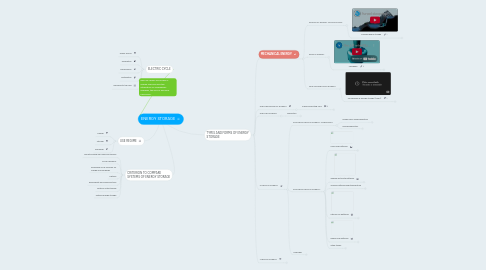
1. ELECTRIC CYCLE
1.1. Power source
1.2. Generation
1.3. Transmission
1.4. Distribution
1.5. Delivered to the user
2. USE REGIME
2.1. Charge
2.2. Storage
2.3. Discharge
3. CRITERION TO COMPARE SYSTEMS OF ENERGY STORAGE
3.1. Density energy per mass and volume
3.2. Cycle efficiency
3.3. Permisible cycle numbers for charge and discharge
3.4. Lifetime
3.5. Reversibility and response time
3.6. Optimal output power
3.7. Optimal energy storage
4. TYPES AND FORMS OF ENERGY STORAGE
4.1. MECHANICAL ENERGY
4.1.1. POTENTIAL ENERGY OR POSITIONAL
4.1.1.1. Pumped hydro storage
4.1.1.1.1. Components:
4.1.1.1.2. Performance:
4.1.1.1.3. Types:
4.1.1.1.4. Advantages:
4.1.1.1.5. Disadvantages:
4.1.1.1.6. Practical examples:
4.1.2. KINETIC ENERGY
4.1.2.1. Flywheels
4.1.2.1.1. Components:
4.1.2.1.2. Performance:
4.1.2.1.3. Types:
4.1.2.1.4. Advantages:
4.1.2.1.5. Disadvantages:
4.1.2.1.6. Practical examples:
4.1.3. GAZ COMPRESSION ENERGY
4.1.3.1. Compresed air energy storage (CAES)
4.1.3.1.1. Components:
4.1.3.1.2. Performance:
4.1.3.1.3. Types:
4.1.3.1.4. Advantages:
4.1.3.1.5. Disadvantages:
4.1.3.1.6. Practical examples:
4.2. ELECTROMAGNETIC ENERGY
4.2.1. Superconducting coils
4.2.1.1. Components
4.2.1.1.1. Superconducting coil
4.2.1.1.2. Cryogenic cooling system
4.2.1.1.3. Power electronic system
4.2.1.2. Performance:
4.2.1.2.1. It is circulated a current through a coil, once loaded, the energy can storage indifinitely, and its available when required.
4.2.1.3. Types:
4.2.1.3.1. The superconducting material can be divide in two groups:
4.2.1.4. Advantages:
4.2.1.4.1. Instantly available energy
4.2.1.4.2. It has high efficiency, above to 95 %
4.2.1.4.3. There is virtually no delay between loading and unloading
4.2.1.4.4. High ciclability, up to millions of cycles
4.2.1.5. Disadvantages:
4.2.1.5.1. Necesidad de un sistema criogénico
4.2.1.5.2. Elementos críticos, scanty for the coil
4.2.1.5.3. Need for modular systems to promote system scalability
4.2.1.6. Practical examples:
4.2.1.6.1. Auxiliary serves mainly on improving the quality of the network system. Some practical examples are mentioned:
4.3. ELECTRIC ENERGY
4.3.1. Capacitors
4.3.1.1. Components:
4.3.1.1.1. Conductive plates (Conductive materials have a conductivity range of 1*10 7-7*10 7 S/m
4.3.1.1.2. Dielectric or insulating materials (Insulating materials have a conductivity <1*10-10 S/m)
4.3.1.2. Performance:
4.3.1.2.1. When power is applied to the system, in one of the plates positive charges are stored and negative charges are stored in the second plate. When the two plates are conected with a conductive wire, the loads are combined, taking place the discharge process.
4.3.1.3. Types:
4.3.1.3.1. By application:
4.3.1.4. Advantages:
4.3.1.4.1. Wide range of capacitors
4.3.1.4.2. Adaptable to the requirements
4.3.1.5. Disadvantages:
4.3.1.5.1. High cost for some applications
4.4. CHEMICAL ENERGY
4.4.1. ELECTROCHEMICAL ENERGY: INTERFACES
4.4.1.1. Double layer supercapacitors
4.4.1.1.1. Components:
4.4.1.1.2. Performance:
4.4.1.1.3. Advantages:
4.4.1.1.4. Disadvantages:
4.4.1.2. Pseudocapacitors
4.4.1.2.1. Components:
4.4.1.2.2. Performance:
4.4.1.2.3. Advantages:
4.4.1.2.4. Disadvantages:
4.4.2. ELECTROCHEMICAL ENERGY:
4.4.2.1. Lead-acid batteries:
4.4.2.1.1. Components:
4.4.2.1.2. Performance:
4.4.2.1.3. Types:
4.4.2.1.4. Advantages:
4.4.2.1.5. Disadvantages:
4.4.2.1.6. Practical examples:
4.4.2.2. Alkaline lectrolyte batteries
4.4.2.2.1. Components:
4.4.2.2.2. Perfomance:
4.4.2.2.3. Types:
4.4.2.2.4. Advantages:
4.4.2.2.5. Disadvantages:
4.4.2.2.6. Practical examples:
4.4.2.3. Sodium batteries high temeprature
4.4.2.3.1. Components:
4.4.2.3.2. Funcionamiento:
4.4.2.3.3. Advantages:
4.4.2.3.4. Disadvantages:
4.4.2.3.5. Practical examples:
4.4.2.4. Lithium-ion batteries
4.4.2.4.1. Components:
4.4.2.4.2. Performance:
4.4.2.4.3. Advantages:
4.4.2.4.4. Disadvantages:
4.4.2.4.5. Practical examples:
4.4.2.5. Redox flow batteries
4.4.2.5.1. Components:
4.4.2.5.2. Performance:
4.4.2.5.3. Types:
4.4.2.5.4. Advantages:
4.4.2.5.5. Disadvantages:
4.4.2.5.6. Practical examples:
4.4.2.6. Other types:
4.4.2.6.1. Air-metal batteries: Metalic anodes (Aluminium, Zinc, Lithium) react with oxygen in the air, releasing electrons. Lithium and Zinc has been the most interesing for their theoric high energy densities of 2000 Wh/kg and 11000 Wh/kg respectively.
4.4.2.6.2. Sodium-ion batteries: This batteries has emerge as altenative to Lithium-ion batteries. Although this battery has lower bennefits than Lithium-ion batteries, they are interesting option due to lower costs and a lifetime of 5000 cycles.
4.4.2.6.3. Lithium-Sulfur and Magnesium-Sulfur batteries: This batteries have a volumetric density of 2600 Wh/l and 4000 Wh/l respectively. Magnesium-Sulfur battery has been the most interesting due to low cost and other benefits. This batteries are still in the research phase.
4.4.3. Hydrogen
4.4.3.1. The hydrogen is an energy carrier currently proposed as the fuel of the future. But nevertheless, there are some challenges that prevent their stablishment in the energy market. The main challenge is its storage. The hydrogen storage, currently, occur through 3 ways:
4.4.3.1.1. Pressure storage tanks:
4.4.3.1.2. Cryogenic storage
4.4.3.1.3. Solids storage:
4.4.3.2. For more information you can see:
4.5. THERMAL ENERGY
4.5.1. SPECIFIC HEAT
4.5.1.1. Heat reservoirs
4.5.1.1.1. Components:
4.5.1.1.2. Performance:
4.5.1.1.3. Types:
4.5.1.1.4. Advantages:
4.5.1.1.5. Disadvantges
4.5.2. LATENT HEAT
4.5.2.1. Phase Change Materials (PCM)
4.5.2.1.1. Components:
4.5.2.1.2. Performance:
4.5.2.1.3. Types:
4.5.2.1.4. Advantges:
4.5.2.1.5. Disadvantages
4.5.3. THERMOCHEMICAL
4.5.3.1. Termochemical materials
4.5.3.1.1. Components:
4.5.3.1.2. Performance:
4.5.3.1.3. Types:
4.5.3.1.4. Advantages:
4.5.3.1.5. Disadvantages:

